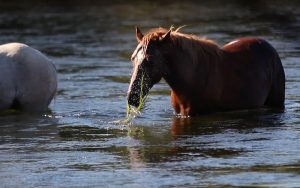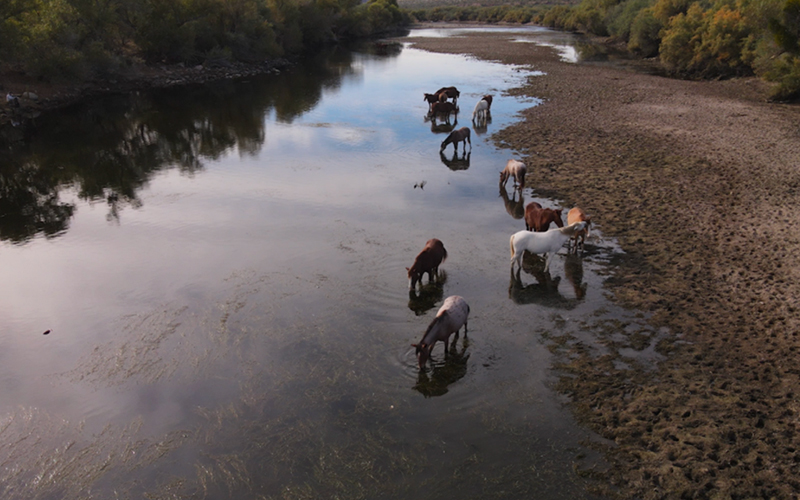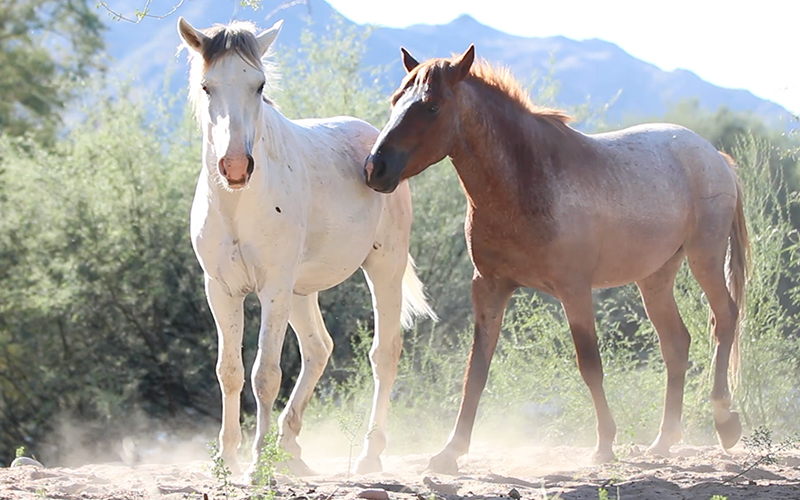MESA – The banks of the Salt River are home to about 440 wild horses in the Tonto National Forest, and they depend on the river for food and water. And advocates again are worried the Salt River Project is jeopardizing that food source by reducing releases from Saguaro Lake.
Simone Netherlands, president of the Salt River Wild Horse Management Group, a nonprofit dedicated to managing and protecting the horses, has been working for two decades to keep the Salt River a safe and stable home for them.
And protecting the horses that live in the Lower Salt River also means protecting their food supply, specifically river eelgrass.
“It just really breaks our heart when we see them lose this resource that they really need for their survival,” Netherlands said.
Nature isn’t the only thing in charge of the Salt River, which runs roughly 200 miles in Gila and Maricopa counties before joining the Gila River southwest of Phoenix. The Salt River Project, a power and water utility formed in 1903, controls river levels by releasing water from Stewart Mountain Dam into the Salt. For the past three years, the horse group has been battling SRP over low releases.
The difference between water levels in summer and winter months is extreme – going from 800 to 1,500 cubic feet per second during summer months to sometimes less than 8 cfs in the winter. The low water means the eelgrass the horses depend on will die out.
Tim Skarupa, the surface water lead for SRP, said the utility is simply responding to long term drought and seasonal demands for water and power.
“From SRP’s perspective, this drought began in the summer of 1995,” Skarupa said. “And because of the way we operate and have been operating throughout our history, we have been able to mitigate this drought even though we have experienced some of the driest winter seasons on record.”
David Stallings, a volunteer for the Salt River Wild Horse Management Group, said the organization has asked SRP to release no less than 100 cfs in winter to protect the eelgrass.
Netherlands understands water releases can’t be the same year-round, but recent flows have been disastrous, she said.
“We are not asking to keep it at 800 to 900 cubic feet per second because that would be unreasonable and cost them a lot of money, and they have too many customers and stakeholders,” she said. “But 100 cfs is about 10% of what they keep it at in the summer, and at 100 cfs we could keep most of the eelgrass alive.”
Skarupa said the request isn’t as simple as it sounds.
“The request to increase those fall releases from 8 cfs to 100 cfs from Stewart Mountain Dam actually puts about 9 billion gallons of water at risk every year that operation is continued,” said Skarupa, noting that saving water every year is crucial because of the megadrought.

A wild horse eats eelgrass from the Salt River northeast of Mesa. (Photo by Megan Newsham/Cronkite News)
However, the wild horse group believes keeping the river levels higher helps the entire ecosystem – including tadpoles, salamanders, frogs, rare reptiles and fish – not just the horses.
“So we could preserve that life and the eelgrass for the entire ecosystem,” Netherlands said.
The management group and SRP were unable to agree, and water releases already are being lowered for the coming winter.
This means the group will have to begin its supplemental feed program, which provides bales of hay divided among four feeding stations along the Salt. The annual cost is about $100,000.
“When the eelgrass dies, it literally translates into more cost for us,” Netherlands said. “And the horses then have to depend on public donation instead of being able to make it on their own the way you want wild horses to.”
In 2015, Netherlands’ group fought the U.S. Forest Service’s plans to remove the animals from the Salt River, where feral horses have lived since at least the late 1800s. A 1927 newspaper article estimated that half a million wild horses roamed Arizona at the time. According to the Bureau of Land Management, there now are fewer than 500 wild horses left in the state.



